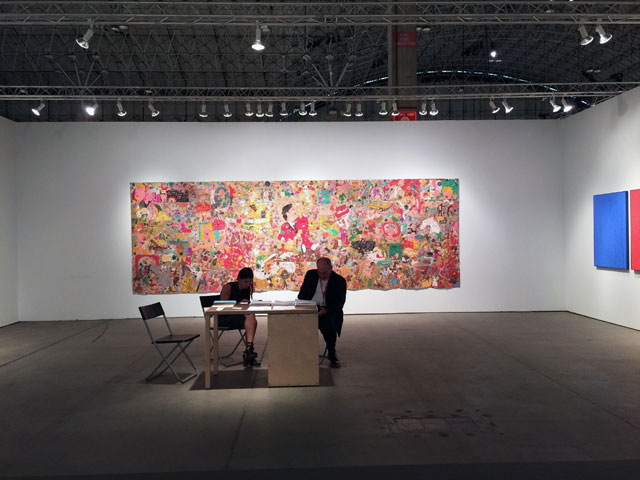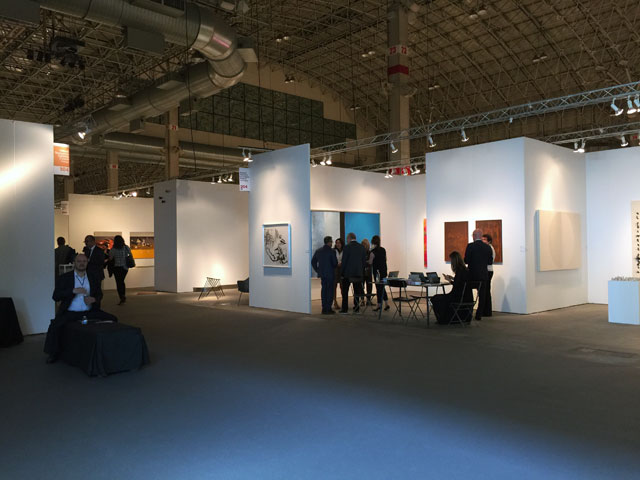
Steve Turner Gallery, installation view
CHICAGO- At around 3 PM yesterday, the EXPO VIP preview looked like a blank canvas. For nearly three hours, only a few collectors had circulated about the fair, a surprise given that there were over 60 new galleries on the fair roster. Those included heavy hitters like Pace, Salon 94, and Steve Turner.
Dealers were getting anxious. It took me twenty minutes to get out of one booth after a Milan dealer held me hostage, regaling the virtues of monochrome paintings that weren’t true monochromes. She didn’t seem to notice I wasn’t interested in the work. Fair veterans seemed less frazzled. “It’s a slower paced fair,” Eleven Rivington’s Augusto Arbizo told me calmly while eating a pretzel. But AFC contributor and Chicagoan Robin Dluzen countered later that even knowing this, the fair seemed slow. I shared her opinion—I was here in 2013—which is why I wasn’t surprised to hear another dealer complain. “Yes, the sales happen late.” she said. Then, referring to the amount of time it might take to close a deal at this fair, she groused, “Don’t ask me how I’ve done until 2016.” It didn’t help her mood that the VIP party she’d attended the night before was populated entirely by partiers not collectors.
By 6PM the visitor numbers had changed. The Museum of Contemporary Art Patron Reception was packed with collectors indulging in small plate food and drinks despite the storm warnings in effect. (Tanta’s ceviche was a particular stand out.) I realized then that the afternoon’s VIP preview was not a mandatory press event for a reason: people don’t show up until 6PM or later.
After having spent the afternoon with dealers who were manning booths in an empty hall, though, I felt a little bad for them. While the collectors were quarantined in the lounge eating their dinner, the dealers were stuck in their booths. Museum of Contemporary Art’s director Madeleine Grynsztejn told audiences during the press remarks they only had one job that night—to buy some good art—but was anyone going to be in the fair long enough to do that?

EXPO installation view.
This bothered me, and when I ran into Thomas Hellstrom, an artist who moved here four years ago from New York, he attributed the event planning to a difference in culture and lifestyle. “The Midwest has a different pace of life,” he said matter of factly. That pace doesn’t align with the narrative EXPO executive director Tony Karman likes to share: two days ago he described EXPO to Artspace as an international fair, the likes of Basel, Frieze, and FIAC that “just happens to serve the Midwest region”. Collectors fly from all over to visit EXPO!
I haven’t noticed this. One curator, in for the Curatorial Form EXPO organized to take place alongside the fair, told me she felt like she was on vacation. She could look around the fair at a leisurely pace without running into hundreds of colleagues. Most galleries I talk to come because they believe the Chicago collector scene is ripe for cultivation. Even Karman himself boasts the local flavor of the fair. During the opening remarks he began to say that “there is no other city in the world that could…” but was drowned out by wild applause. Said applause seemed to muffle the incongruity of Karman’s boasts with what was actually happening on the floor.
As for the quality of the art at EXPO, though the exhibitor roster is impressive, a lot of the work felt conservative. Standards such as monochromes, blurry paintings and geometric abstraction carpeted the showroom. Few booths launched the kind immersive installations that define a good fair. That’s not to say there weren’t highlights—almost everyone I talked could name a stand out booth, myself included—but over all, EXPO’s ambitions may still outpace what it delivers.


Comments on this entry are closed.